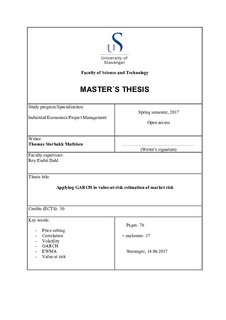Applying GARCH in value-at-risk estimation of market risk
Master thesis
Permanent lenke
http://hdl.handle.net/11250/2456248Utgivelsesdato
2017-06-14Metadata
Vis full innførselSamlinger
- Studentoppgaver (TN-ISØP) [1441]
Sammendrag
This thesis tests the correlation between four commodities and eight stocks of companies consuming or producing the commodities. The commodities include oil, gas, salmon and aluminum, while the stocks are Statoil, Seadrill, DNO, Lufthansa, SAS, Norwegian, MHG and Norsk Hydro. Further it tests value-at-risk (VaR) estimation of market risk using EWMA and GARCH models to improve the historical model of volatility. This is done by modelling volatility of the data and using it to calculate VaR for the given sample period. All the results are backtested using Kupiec and Christoffersen tests to see what model produces the best results.
For the correlation, all stocks are affected by the volatility and follows the oil and gas prices. Also salmon is found to have an impact on all stocks, which is suspected to be related to the salmon price`s correlation with the Norwegian economy, which in general follows the oil price. Aluminum has a more random affect on the stocks, affecting mostly airlines and oil service companies as they are more dependent on aluminum price for their equipment.
The VaR estimation results show that the EWMA performs best for the four commodities, although only at 5% significance level. The GARCH models, and in particular EGARCH has a slightly better result on the stock volatility. Also here only at 5% significance level, as all models fail to model the volatility at 1%. The extreme values are not modelled adequately, and in this thesis the VaR values during crisis are not acceptable, which is when it is needed most. A further improvement on the models using extreme value theory and generalised error distribution might elevate the accuracy.
Beskrivelse
Master's thesis in Industrial economics

